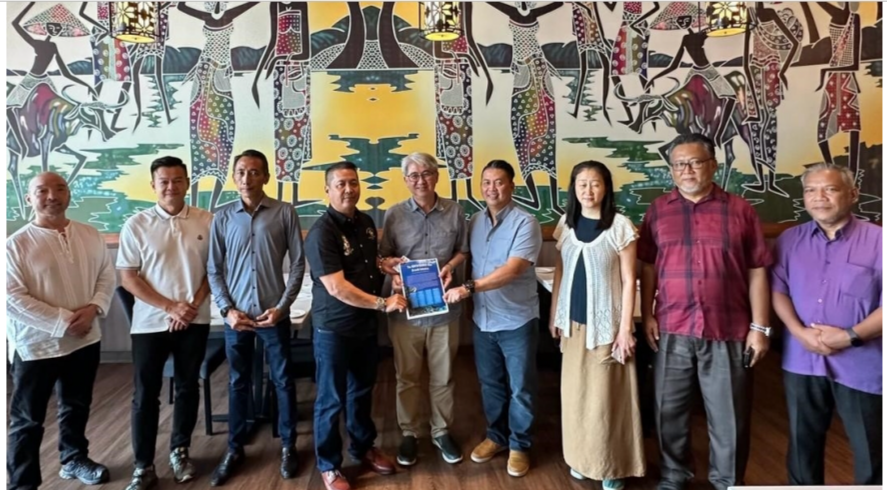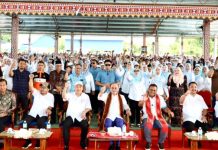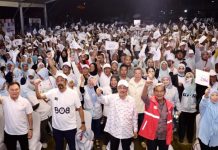KOTA KINABALU: The recent remark by Minister of Agriculture and Food Industries Datuk Dr Jeffrey Kitingan about SAFMA urged to take steps, seize opportunities In Blue Economy is welcomed by Dr Raymond Alfred (Chairman of BIMP EAGA Business Council, Malaysia (Sabah) and Asso. Prof. Dr Rayner Alfred (Founder and director of the Creative Advanced Machine Intelligence Research Centre in Universiti Malaysia Sabah).
The Technical Implementation Action Plan for the North Borneo Blue Growth Initiatives is currently prepared By Dr Raymond Alfred (Chairman of BIMP EAGA Business Council, Malaysia (Sabah) and Asso. Prof. Dr Rayner Alfred (Founder and director of the Creative Advanced Machine Intelligence Research Centre in Universiti Malaysia Sabah) to provide the background, justification, and the overall goals of the Blue Economy-based Projects that will be implemented in BIMP EAGA Region especially covering Sabah Marine Landscape.
The Technical Implementation Action Plan covers the World Blue Economy Framework which emphasizes the potential contribution of the World Blue Economy and challenges undermining the blue economy.
Blue economy contributes to food security, nutrition-health, livelihoods, mitigation of climate change, homes-shelter, sustainable economic growth, and trade to the world population.
The Challenges undermining the blue economy, includes overfishing, habitat degradation, climate change related phenomena, unfair trade, ad hoc development, and complexity of Comprehensive Strategy.
For example, coastal zone management efforts, or support to coastal fishers, are undermined by unbridled sand mining, ill-sited ports or aquaculture farms or unregulated tourism development.
In coastal zones, declines in mangrove forest habitat resulting from wood harvest, sea level rise, and changes in sediment and pollutant loading from river basins (due to plantation development or timber management at the upper catchment combined with land reclamation for agriculture or infrastructure) has negatively impact fisheries by reducing or degrading spawning and feeding habitats.
Previous study shows that the Mangrove-rich areas produce an average of 71 percent more fish biomass than areas with few mangroves.
The Technical Implementation Action Plan also provides details information on Blue Economy Growth in the East Asian Seas Region.
The East Asian Seas (EAS) region is recognized as the centre of marine biodiversity globally, being home to 31% of the world’s mangroves, 33% of seagrass beds and a third of the world’s coral reefs. Countries of the EAS region account for 80% of global aquaculture, and around 60% of the world’s capture fisheries.
Moreover, the region’s seas serve as an important conduit for 90% of world trade through shipping. 75% of the East Asian Seas Region comprises of BIMP-EAGA Regional Marine Area (which includes islands and coastlines).
BIMP EAGA, however faces natural and human-induced environmental threats, such as unsustainable practices in agriculture, industry, manufacturing, and services. It also needs to deal with changing land use patterns (due to oil palm plantation and timber operation at the upper catchment) including due to rapid urbanization and a growing population; unregulated illegal fishing; illegal conversion of forest lands into plantations; lack of capacity, especially among smallholder farmers, to effectively mitigate and adapt to the effects of climate change.
The BIMP EAGA uses sustainable management approaches to economic development. These include the development of measures and action plan in promoting ecotourism, sustainable and climate- resilient farming and fishing practices, and clean and green production technology.
This The Technical Implementation Action Plan finally outlines at least 9 strategies to be delivered to support the Blue Economy programme which will contribute to BIMP EAG Areas, East Asian Seas Areas and to the World. Nine (9) Strategies development through project establishment includes.
1. Development and Establishment of Research-based Smart Farming (Land-based Aquaculture and Agriculture),
2. Development of Certification of Seafood Processing Hub, associated Product Marketing.
3. Renewable Energy Establishment to support Blue Economy-based Industrial Programme,
4. Development of Community-based Eco-tourism project,
5. Certification of Green Port including Carbon Capture & Storage Initiative,
6. Development and Establishment of Halal Hub within the Blue Economy Landscape,
7. Community-based Terrestrial and Marine Habitat Restoration Programme,
8. Development E-Commerce AI Matching and Strategic Monitoring programme as a tool for Blue Economy Management in BIMP EAGA, and
9. Development and Establishment of Financing Mechanism to Support Human Capital
Development (including cooperation in terms of technology in the use of vessels and fishing
methods) in Managing Blue Economy in BIMP EAGA.
By the implementation of these 9 strategies (based on project), the overall Blue Economy
requirement in the Sabah (at the BIMP EAGA Marine Landscape) can be fulfilled and goals can be achieved.
Dr Alfred said, with the support and leadership from the Special Envoy of BIMP EAGA Sabah, Tan Sri Pandikar Amin Haji Mulia, BIMP EAGA Business Council can further contribute effectively on the ground within the North Borneo Marine Landscape.
Dr Alfred also emphasize the need to conduct a Details Cost Benefit Analysis for the proposed Silica Sand Mining (1,060 Hectares) at Pulau Balambangan, Kudat, Sabah, comparing the revenue projected if proper Blue Economy programme is conducted in the surrounding marine ecological landscapes.
The extraction of silica from the Island, significantly impacts the environment, human health, and communities near mining operations, especially the Tun Mustapha Marine Park. Silica is widely used in various industries due to its unique properties, but the extraction process and associated activities can have detrimental consequences.
Dr Alfred added that clearing vegetation and soil erosion during mining operations can result in habitat destruction, biodiversity loss, and ecosystem disruption. The removal of vegetation can also contribute to increased runoff and soil degradation. Additionally, the excavation of mines and deposition of waste materials can alter the topography and hydrology of the area, affecting natural drainage patterns and water availability, hence deteriorating the water quality around the Marine Landscape. Dr Alfred recommended for the Government to take one step behind before deciding the project to be proceeded, which is to conduct Details Cost and Benefit Analysis of the project versus the Blue Growth Initiative.
Dr Alfred also highlight that one of the major concerns associated with silica mining is the
generation of fine silica dust, known as respirable crystalline silica (RCS). The crushing,
grinding, and handling of silica ore release RCS particles into the air, which workers and nearby communities can inhale. Prolonged exposure (more than 3 years) to RCS can lead to serious respiratory diseases such as silicosis, lung cancer, and chronic obstructive pulmonary disease (COPD).-pr/BNN






